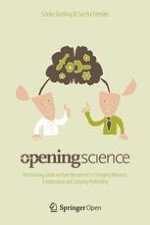Open Access 2014 | Open Access | Book

Opening Science
The Evolving Guide on How the Internet is Changing Research, Collaboration and Scholarly Publishing
Editors: Sönke Bartling, Sascha Friesike
Publisher: Springer International Publishing
Open Access 2014 | Open Access | Book

Editors: Sönke Bartling, Sascha Friesike
Publisher: Springer International Publishing
Modern information and communication technologies, together with a cultural upheaval within the research community, have profoundly changed research in nearly every aspect. Ranging from sharing and discussing ideas in social networks for scientists to new collaborative environments and novel publication formats, knowledge creation and dissemination as we know it is experiencing a vigorous shift towards increased transparency, collaboration and accessibility. Many assume that research workflows will change more in the next 20 years than they have in the last 200. This book provides researchers, decision makers, and other scientific stakeholders with a snapshot of the basics, the tools, and the underlying visions that drive the current scientific (r)evolution, often called ‘Open Science.’